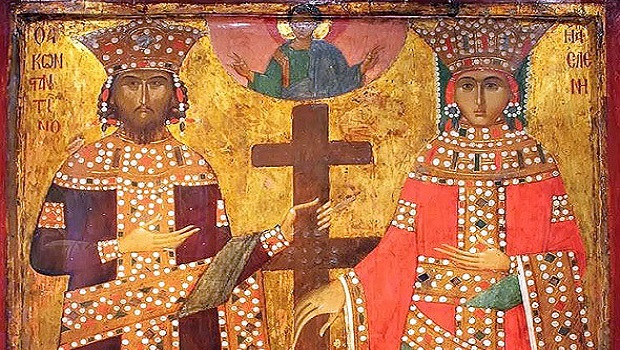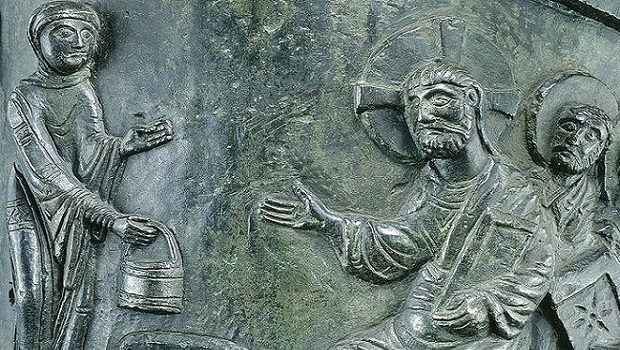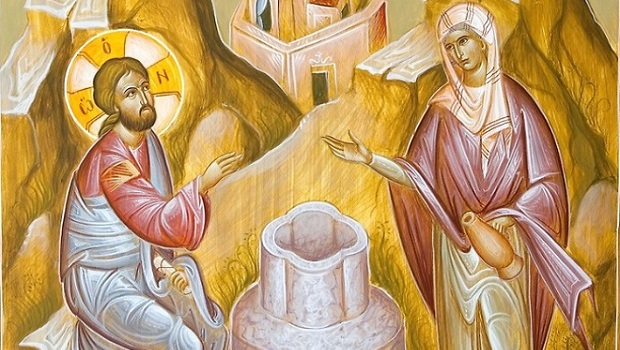Rafael Ch. Misiaoulis
Saint Gregory Palamas occupies a very prominent position in the Church, which is why he’s honoured on the Second Sunday in Lent, immediately after the Sunday of Orthodoxy. In his person we recognize the outstanding teacher of the hesychast life in Christ, a man who continued the Orthodox faith and added to its lustre.
Saint Gregory was born in 1296 in Constantinople to aristocratic parents, Konstantinos and Kalloni, devout people who brought up their children in the ‘discipline and instruction of the Lord’ (Eph. 6, 4). They taught their children to live in accordance with the will of Christ, Who was the centre of their life. It is noteworthy that, shortly before his father departed this life, he commended his children into the care of Our Most Holy Lady, the Mother of God.
The saint attended the university of his birthplace, Constantinople, where he studied grammar, rhetoric, physics, philosophy and logic. At the age of twenty he withdrew to Mount Papikio and then to a variety of locations on Mount Athos. At the Monastery of Vatopaidi he was under the tutelage of Nikodimos the hesychast, and thereafter he went on to the Great Lavra, before settling as a hermit in Glossia, under the guidance of the monk Grigorios. Because of the raids by Turkish pirates on the Athos region, he wanted to go to Jerusalem and Sinai, but, before doing so, he spent a short time in Thessaloniki.
After this he left, together with 10 other priests, for the Skete of Veria, where he remained for five consecutive years, in strict isolation. In 1331, because of the demise of his mother, he returned to the Holy Mountain, where he became abbot of the Monastery of Esfigmenou. As abbot, he displayed all his great gifts, being ‘simple in morals, free in thinking, and sweet in speech…’.
In the first half of the 14th century, the hesychast movement made its appearance in Byzantium, and this became the occasion for confrontations and intense polemics. The leader of the opposition of the Hesychasts was a Greek monk, Varlaam, who together with one Akindynos and others of like mind, scoffed at the Hesychasts and called them heretics. In 1337, Varlaam went to Constantinople, aiming to have a synod arranged at which the hesychasts would be condemned, since he considered that their tradition was foreign to Orthodoxy, which he believed he truly represented. This was the spark for open conflict. Part of the doctrine of Varlaam’s movement was that they accepted God only as essence, without divine energies. If we accept that, the fact that God only has essence, then we also accept pantheism, in other words that everything around us has God’s essence, too. Moreover, if we accept that God does not have energies, as the movement of Varlaam claimed was the case, then we, as people, are of the same essence or substance as God. But we know that only the three persons of the Holy Trinity are of one substance. We are therefore brought to the conclusion that Varlaam and his fellow-thinkers were preaching a heresy, which denied the vision of God, that is the salvation of the human race.
Metropolitan Isidoros of Thessaloniki, who was well aware of Palamas’ gifts, recalled him from the Holy Mountain to Thessaloniki because of the trials the Church was undergoing as a result of Varlaam’s heresy. Gregory returned to Thessaloniki and met with Varlaam, though without the desired outcome, which would have been for Varlaam to recant.
Then, during the civil war between Ioannis Palaiologos and Ioannis Kantakouzinos, Patriarch Ioannis (Kalekas) changed his views on hesychasm, with the result that his flock was divided, and Palamas was attacked because of his refusal to subscribe to the position taken by the Patriarch. The saint was imprisoned for four years before being released after a change in the ecclesiastical and political situation. He was then consecrated Metropolitan of Thessaloniki, though the Zealots there refused to allow him to enter the city for his enthronement, forcing him instead to find refuge on the Holy Mountain. They soon recognized their mistake, however, and asked him to return to Thessaloniki. He did so in 1350 and a new era dawned for the second city of the empire of New Rome.
The end goal of his pastoral work was glorification, and he therefore guided his flock so that they would attain the first stage of the spiritual struggle, which is liberation from the passions and participation in the Sacraments of our Orthodox Church. Beyond that, it was his aim to protect his flock from heresies. He was patient, charitable, meek, humble, prayerful and charismatic. He celebrated the liturgy and preached frequently; wanted there to be peace towards God, and his neighbours; condemned the misuse of wealth and the mania for acquiring it; derided callousness and social injustice; took steps to ensure the training of the clergy; and, finally, also had a care for us, the generations who have succeeded him, by bequeathing to us his literary work.
It would not be amiss to mention the five hesychast synods which are associated with the name of Saint Gregory Palamas. At the First Hesychast Synod, which was held on 10 June, 1342 in the church of Holy Wisdom in Constantinople, in the presence of Patriarch Ioannis, the clergy and monks, Varlaam was condemned and Palamas vindicated.
The dispute did not end here, however, but was rekindled by Grigorios Akindynos, a supporter of Varlaam’s positions. So it was that, in July, 1341, the Patriarch convoked another synod, with both Palamas and Akindynos in attendance. Akindynos was condemned (verbally) and the co-Emperor Ioannis Kantakuouzinos sided with Palamas.
Then, in 1347, a synod was convened in the Royal Palace at which Akindynos was condemned and Patriarch Ioannis Kalekas was defrocked, as being a Varlaamite. The hesychast Isidoros I was elected to replace him and he reinstated Gregory Palamas as Archbishop of Thessaloniki.
Palamas’ opponents, however, gave no sign of submitting, and so, in 1351, a synod was convened with the aim of settling the dispute once and for all. Those opposing Palamas were the monk Nikiforos Grigoras and the Metropolitans Iosif of Ganos and Matthaios of Ephesus. By God’s grace, the teaching of Palamas was confirmed, Akindynos was condemned and the Metropolitans mentioned were defrocked, as were their supporters. It is worth noting that the resolutions of this Synod were included in the Synodiko of Orthodoxy, which makes these decisions official and binding.
In 1368, the dispute was ignited yet again, this time by a monk called Prokhoros Kydonis, who was referred to Patriarch Filotheos Kokkinos as a supporter of Varlaam and Akindynos. He was brought before the synod of 1368, where he was condemned, and Gregory Palamas was recognized as a Saint of the One, Holy, Catholic and Apostolic Church.
The Church adopted Saint Gregory’s teachings officially at two synods which were held in Constantinople in 1341 and 1351 respectively.
The saint fell asleep in the Lord at the age of 63, having foreseen the day of his demise.
The person who proposed the canonization of Saint Gregory was the same man who wrote his Life and order of service: Saint Filotheos Kokkinos, Patriarch of Constantinople, a fellow monk and supporter of the same hesychast tradition.
By a synodal decision of the Ecumenical Patriarchate in 1368, Gregory Palamas was officially proclaimed a saint of the Orthodox Church. He is commemorated on November 14 each year, and also on the Second Sunday of Great Lent, as a continuation of the Sunday of Orthodoxy, since the victory over the heretical doctrines of Varlaam is considered to be on a par with that of the triumph over the iconoclasts.
The holy relics of Saint Gregory Palamas lie in the Cathedral Church of the Metropolis of Thessaloniki, which is dedicated to him.
By his holy prayers, Lord, have mercy upon us and save us.
Source: pemptousia.com
ABOUT THE ORTHODOX CHRISTIAN NETWORK
Orthodox Christian Network (OCN) is a 501(c)3 and an official agency of the Assembly of Canonical Bishops of the United States of America . It is a recognized leader in the Orthodox Media field and has sustained consistent growth over twenty-two years. We have worked to create a community for both believers and non believers alike by sharing the timeless faith of Orthodoxy with the contemporary world through modern media. We are on a mission to inspire Orthodox Christians Worldwide. Click to signup to receive weekly newsletter.
Join us in our Media Ministry Missions! Help us bring the Orthodox Faith to the fingertips of Orthodox Christians worldwide! Your gift today will helps us produce and provide unlimited access to Orthodox faith-inspiring programming, services and community. Don’t wait. Share the Love of Orthodoxy Today!
OCN has partnered with Pemptousia. A Contemporary post-modern man does not understand what man is. Through its presence in the internet world, Pemptousia, with its spirit of respect for beauty that characterizes it, wishes to contribute to the presentation of a better meaning of life for man, to the search for the ontological dimension of man, and to the awareness of the unfathomable mystery of man who is always in Christ in the process of becoming, of man who is in the image of divine beauty. And the beauty of man springs from the beauty of the Triune God. In the end, “beauty will save the world”.




0 Comments